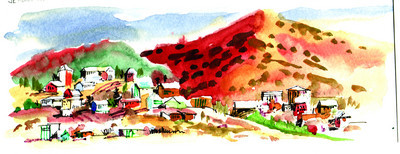Jerome allows visitors to experience beautiful scenery

Perhaps the liveliest ghost town in Arizona, old Jerome lures visitors with its colorful past, picturesque downtown, splendid scenery and thriving arts community. Located halfway up a mountain in central Arizona, Jerome straddles scenic Highway 89 A, a position only a mining town would occupy.
The former copper mining center lies 285 miles from Las Vegas using U.S. 93, Interstate 40 and Highway 89 toward Prescott. Turn onto 89 A for a dramatic approach over Mingus Mountain, a steep, scenic route closed to those hauling large trailers. They should use routes through Prescott or Kingman instead.
Jerome’s precipitous streets overlook the beautiful Verde Valley with the striking red cliffs surrounding Sedona in the distance. The highway takes hairpin turns through town, its bridges cantilevered over the slopes. Along streets terraced from the hillsides, Jerome’s old buildings crowd the town’s three levels, their backsides often shored up by posts and framework supports. Visitors park wherever they find space and explore the town’s commercial district on foot.
Long before Jerome boomed, its location attracted native people seeking the colorful rocks of the region. Spanish explorers noted the Indian diggings in 1582, the diggins were still in place 300 years later when prospectors identified copper ore in 1876. A small tent city appeared near the site of several mining claims, named for a principal financial backer, Eugene Jerome, a relation of Jenny Jerome, Winston Churchill’s American mother.
Original claim holders sold out to the United Verde Copper Company in 1883, an enterprise doomed to failure in two years by high operating costs and shipping fees. Investment by mining and railroad magnate William A. Clark breathed new life into the faltering company and the little town on the hillside near its mine. Soon a narrow gauge railway hauled the ore down the mountain into the valley for processing and shipment on a larger railway.
Jerome ranked as Arizona’s largest copper producer by the early 1900s. A tent city no more, it boasted substantial brick buildings and frame houses. Its population swelled to 15,000 despite fires and landslides.
Newcomer James S. Douglas, scion of a copper mining family, purchased mining interests in Jerome in 1912, developing the Little Daisy Mine as a competitor to the United Verde holdings. Discovery of rich ore deposits just prior to World War I made the Little Daisy into Jerome’s second bonanza mine. In 1916, Douglas began construction of a fine home on a hill near town suitable as a family residence and for housing visiting mining men. Visitors today tour the gracious Douglas home, learning about Jerome’s past through exhibits at Jerome State Historic Park open daily from 8 a.m. to 5 p.m., except Christmas Day.
Jerome struggled for decades after the 1929 financial crash that brought on the Great Depression. It suffered a near fatal decline after its last mine closed in 1953. From a heyday population of 15,000, it dwindled to just 50 residents who stubbornly protected what was left.
Jerome’s revival began with an influx of urban refugees in the 1960s and 70s, including many artists and craftsmen who turned old buildings into studios, galleries and shops. At the edge of town, the adobe Douglas mansion gained protection in 1965 as an Arizona state park. Jerome’s designation as a National Historic Landmark in 1976 gave it recognition, assuring a brighter future. Several hundred people now call Jerome their home, and hundreds visit there daily.
Special events in Jerome continue to draw crowds, including a May historic home tour and free art walks downtown on the first Saturday of the month all year. Join artists and craftsmen for art, music, refreshments and entertainment during the last Jerome Art Walk of the year on Dec. 1, from 5 to 8 p.m. Stroll through 30 downtown galleries, studios and artists’ cooperatives. Use the free shuttle to visit the refurbished Jerome High School with its working artists. Dress warmly, for Jerome’s mile-high location makes for chilly evenings.
Consider staying overnight in one of Jerome’s charming inns or historic hotels. Nearby Cottonwood, Sedona and Prescott also offer accommodations.
Margo Bartlett Pesek’s column appears on Sundays.
MARGO BARTLETT PESEKMORE COLUMNS











